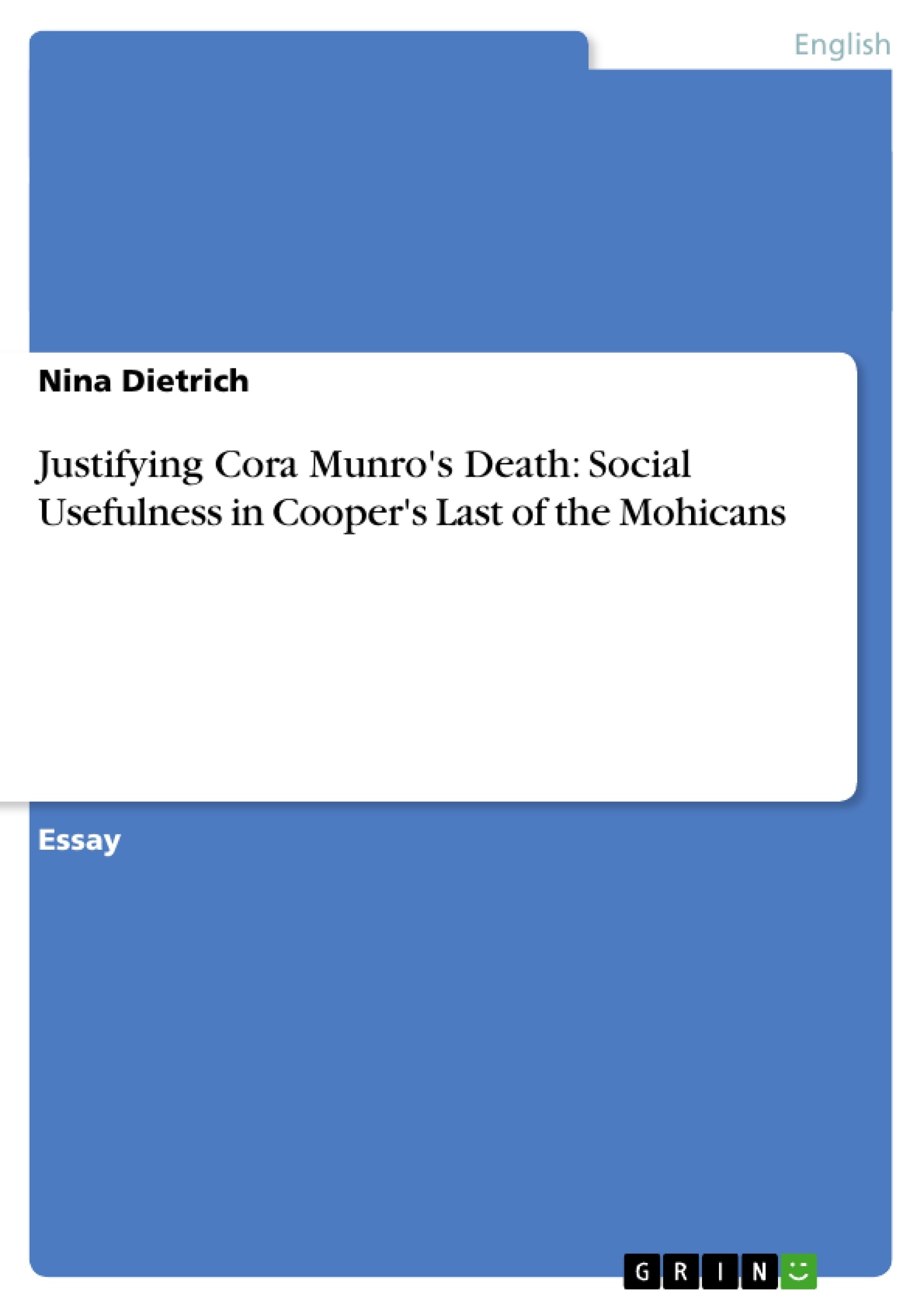In James Fenimore Cooper’s fiction, ‘women are of central social significance.
[Cooper’s] theme is society, and he defines women as the nexus of social interaction,’
Nina Baym argues1. She claims that the author is not interested in women’s personhood
or individuality, but rather in their usefulness for society. According to Baym,
matrimony is ‘the chief “statement” of the social language’.2 Therefore, if a woman is
apt for marriage, she is socially utile. One of the main aspects of The Last of the
Mohicans is the dichotomy between the half-sisters Cora and Alice Munro, to whom the
concept of social usefulness can be applied. On the one hand, Fenimore Cooper presents
Alice, who is fair, helpless and infant ile, as marriageable. On other hand, Cora, the dark,
courageous and initiated sister, is considered unsuitable for wifehood. Instead of letting
Cora be united in marriage with the Indian Uncas in the end of the novel, the author
decides to kill both of the m. Many of his contemporaries have urged Cooper to change
the unhappy ending. One critic, for instance, writes:
Every event as we go along points to a favourable termination, when just at the
winding up, the design seems to be capriciously reversed, and [Cora and Uncas]
are most summarily and unnecessarily disposed of. The vessel, having braved all
the dangers of her voyage, sinks as she is floating into smooth water.3
1 Nina Baym, ‘The Women of Cooper’s Leatherstocking Tales’, American Quarterly 23
(1971), p. 697.
2 Ibid., p. 698.
3 Unsigned review, The United States Literary Gazette, iv (May 1826), pp 87-94,
reprinted in George Dekker and John P. McWilliams (eds.), Fenimore Cooper the
Critical Heritage, Routledge and Kegan Paul, 1973, p. 100.
Table of Contents
- Justifying Cora Munro's Death: Social Usefulness in James Fenimore Cooper's The Last of the Mohicans
- Cora and Alice's Outward Appearance and Racial Background
- Cora and Alice's Dichotomous Character Traits
- Alice's Helplessness and Dependency
- Gender Roles in the 18th and 19th Century
- Cora's Refusal to Conform to Gender Norms
- Cora's Racial Background and Her Relation to Native Americans
- Cora's Adaptability to the Wilderness
- Cooper's Attitude Towards Racial and Cultural Miscegenation
Objectives and Key Themes
This essay examines the death of Cora Munro in James Fenimore Cooper's The Last of the Mohicans and explores the reasons why Cooper chose to kill his heroine rather than allowing her to marry either Major Heyward or Uncas. The essay focuses on the concept of "social usefulness" as defined by Nina Baym, analyzing the character traits and racial backgrounds of Cora and her sister Alice in relation to the gender expectations and racial prejudices of 18th and 19th century America. The essay also examines Cooper's opinion on multiracialism and the potential for harmony between different racial groups in the New World.
- Social usefulness as a defining factor in women's roles and societal expectations
- The dichotomy between Cora and Alice's character traits and their suitability for marriage
- The impact of racial prejudice and miscegenation on the characters' destinies
- The role of gender expectations in shaping the narrative and characters' fates
- Cooper's perspective on multiracialism and the potential for harmonious coexistence in the New World
Chapter Summaries
- The first chapter introduces the reader to Cora and Alice Munro, highlighting their contrasting appearances and racial backgrounds. Cora's mixed heritage is revealed, setting the stage for an exploration of her social and cultural complexities.
- Chapter 8 presents a key moment of divergence between the sisters. While Alice succumbs to fear and helplessness, Cora displays remarkable courage and strength in the face of imminent danger. This chapter emphasizes their contrasting character traits and their suitability for different societal roles.
- Through a detailed examination of 18th and 19th-century gender expectations, the essay explores why Cora's independent and self-reliant nature, while admirable today, made her socially "useless" in the eyes of her time. The analysis focuses on the societal pressure on women to conform to submissive and passive roles.
- The essay challenges the notion of social usefulness by considering Cora's relationship with Uncas and her potential for integration into Native American culture. The essay explores how Cora's adaptability to the wilderness and her strong character traits could have made her an ideal partner for Uncas.
Keywords
The primary keywords and focus topics of this essay include social usefulness, gender roles, racial prejudice, miscegenation, multiracialism, adaptability, and the contrasting characters of Cora Munro and Alice Munro in James Fenimore Cooper's The Last of the Mohicans. These concepts are used to explore the complex social and cultural dynamics of the novel and the reasons behind Cora's tragic fate.
- Quote paper
- Nina Dietrich (Author), 2002, Justifying Cora Munro's Death: Social Usefulness in Cooper's Last of the Mohicans, Munich, GRIN Verlag, https://www.grin.com/document/19971




